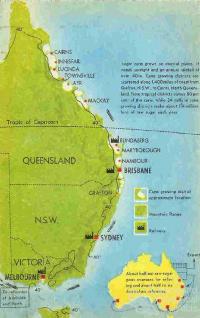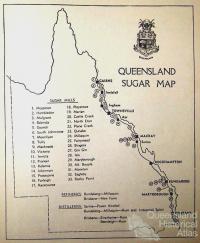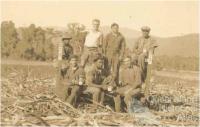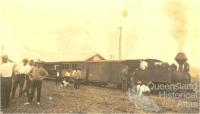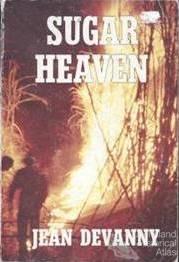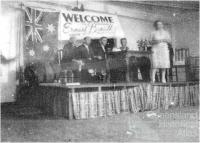- Home
- Quintessential Queensland
- Distinctiveness
- Perceptions
- Perceptions: how people understand the landscape
- From runs to closer settlement
- Geological survey of Queensland
- Mapping a new colony, 1860-80
- Mapping the Torres Strait: from TI to Magani Malu and Zenadh Kes
- Order in Paradise: a colonial gold field
- Queensland atlas, 1865
- Queensland mapping since 1900
- Queensland: the slogan state
- Rainforests of North Queensland
- Walkabout
- Queenslanders
- Queenslanders: people in the landscape
- Aboriginal heroes: episodes in the colonial landscape
- Australian South Sea Islanders
- Cane fields and solidarity in the multiethnic north
- Chinatowns
- Colonial immigration to Queensland
- Greek Cafés in the landscape of Queensland
- Hispanics and human rights in Queensland’s public spaces
- Italians in north Queensland
- Lebanese in rural Queensland
- Queensland clothing
- Queensland for ‘the best kind of population, primary producers’
- Too remote, too primitive and too expensive: Scandinavian settlers in colonial Queensland
- Distance
- Movement
- Movement: how people move through the landscape
- Air travel in Queensland
- Bicycling through Brisbane, 1896
- Cobb & Co
- Journey to Hayman Island, 1938
- Law and story-strings
- Mobile kids: children’s explorations of Cherbourg
- Movable heritage of North Queensland
- Passages to India: military linkages with Queensland
- The Queen in Queensland, 1954
- Transient Chinese in colonial Queensland
- Travelling times by rail
- Pathways
- Pathways: how things move through the landscape and where they are made
- Aboriginal dreaming paths and trading ways
- Chinese traders in the nineteenth century
- Introducing the cane toad
- Pituri bag
- Press and the media
- Radio in Queensland
- Red Cross Society and World War I in Queensland
- The telephone in Queensland
- Where did the trams go?
- ‘A little bit of love for me and a murder for my old man’: the Queensland Bush Book Club
- Movement
- Division
- Separation
- Separation: divisions in the landscape
- Asylums in the landscape
- Brisbane River
- Changing landscape of radicalism
- Civil government boundaries
- Convict Brisbane
- Dividing Queensland - Pauline Hanson’s One Nation Party
- High water mark: the shifting electoral landscape 2001-12
- Hospitals in the landscape
- Indigenous health
- Palm Island
- Secession movements
- Separate spheres: gender and dress codes
- Separating land, separating culture
- Stone walls do a prison make: law on the landscape
- The 1967 Referendum – the State comes together?
- Utopian communities
- Whiteness in the tropics
- Conflict
- Conflict: how people contest the landscape
- A tale of two elections – One Nation and political protest
- Battle of Brisbane – Australian masculinity under threat
- Dangerous spaces - youth politics in Brisbane, 1960s-70s
- Fortress Queensland 1942-45
- Grassy hills: colonial defence and coastal forts
- Great Shearers’ Strike of 1891
- Iwasaki project
- Johannes Bjelke-Petersen: straddling a barbed wire fence
- Mount Etna: Queensland's longest environmental conflict
- Native Police
- Skyrail Cairns (Research notes)
- Staunch but conservative – the trade union movement in Rockhampton
- The Chinese question
- Thomas Wentworth Wills and Cullin-la-ringo Station
- Separation
- Dreaming
- Imagination
- Imagination: how people have imagined Queensland
- Brisbane River and Moreton Bay: Thomas Welsby
- Changing views of the Glasshouse Mountains
- Imagining Queensland in film and television production
- Jacaranda
- Literary mapping of Brisbane in the 1990s
- Looking at Mount Coot-tha
- Mapping the Macqueen farm
- Mapping the mythic: Hugh Sawrey's ‘outback’
- People’s Republic of Woodford
- Poinsettia city: Brisbane’s flower
- The Pineapple Girl
- The writers of Tamborine Mountain
- Vance and Nettie Palmer
- Memory
- Memory: how people remember the landscape
- Anna Wickham: the memory of a moment
- Berajondo and Mill Point: remembering place and landscape
- Cemeteries in the landscape
- Landscapes of memory: Tjapukai Dance Theatre and Laura Festival
- Monuments and memory: T.J. Byrnes and T.J. Ryan
- Out where the dead towns lie
- Queensland in miniature: the Brisbane Exhibition
- Roadside ++++ memorials
- Shipwrecks as graves
- The Dame in the tropics: Nellie Melba
- Tinnenburra
- Vanished heritage
- War memorials
- Curiosity
- Curiosity: knowledge through the landscape
- A playground for science: Great Barrier Reef
- Duboisia hopwoodii: a colonial curiosity
- Great Artesian Basin: water from deeper down
- In search of Landsborough
- James Cook’s hundred days in Queensland
- Mutual curiosity – Aboriginal people and explorers
- Queensland Acclimatisation Society
- Queensland’s own sea monster: a curious tale of loss and regret
- St Lucia: degrees of landscape
- Townsville’s Mount St John Zoo
- Imagination
- Development
- Exploitation
- Transformation
- Transformation: how the landscape has changed and been modified
- Cultivation
- Empire and agribusiness: the Australian Mercantile Land and Finance Company
- Gold
- Kill, cure, or strangle: Atherton Tablelands
- National parks in Queensland
- Pastoralism 1860s–1915
- Prickly pear
- Repurchasing estates: the transformation of Durundur
- Soil
- Sugar
- Sunshine Coast
- The Brigalow
- Walter Reid Cultural Centre, Rockhampton: back again
- Survival
- Survival: how the landscape impacts on people
- Brisbane floods: 1893 to the summer of sorrow
- City of the Damned: how the media embraced the Brisbane floods
- Depression era
- Did Clem Jones save Brisbane from flood?
- Droughts and floods and rail
- Missions and reserves
- Queensland British Food Corporation
- Rockhampton’s great flood of 1918
- Station homesteads
- Tropical cyclones
- Wreck of the Quetta
- Pleasure
- Pleasure: how people enjoy the landscape
- Bushwalking in Queensland
- Cherbourg that’s my home: celebrating landscape through song
- Creating rural attractions
- Festivals
- Queer pleasure: masculinity, male homosexuality and public space
- Railway refreshment rooms
- Regional cinema
- Schoolies week: a festival of misrule
- The sporting landscape
- Visiting the Great Barrier Reef
By:
Robert Mason Queensland sugarcane fields were riven with ethnic divisions between Anglo-Celts and migrants with non-English speaking backgrounds from southern Europe. The towns, ports and railways associated with the cane fields were profoundly influenced by the social and political networks of the migrants who traversed the north’s harsh physical environment. These fractures in the region’s radical egalitarianism became anchored in the local landscape, determining relationships to public space and engagement in cultural landscapes.
Developing local space
From 1901, it was believed that the north’s undeveloped rainforests and plains would be central to Australia’s future viability as an emerging nation. Accessible only by ship from Brisbane, the fertile region promised great opportunity to secure the white egalitarian society that many feared was under global threat. Not only was the establishment of farms by white settlers considered to be morally appealing, but it promised to secure Australia’s thinly populated northern border from imagined threats of expansionist ‘yellow hordes’ to the country’s north.
In fact, few northern Europeans settled permanently in the north. Instead, the region came to be characterised by an unusually ethnically diverse population. The rapid expansion of land cultivated to produce cane had been predicated on forced labour from the Pacific Islands, while many business owners in the region originated from East Asia or the Eastern Mediterranean. This ethnic mix in a strategically vulnerable area was widely imagined to pose a security risk to the whole of Australia. The White Australia Policy, adopted as a cornerstone of Federation in 1901, thenceforth restricted the entry of non-white migrants to Australian ports and pressured existing residents to leave. The policy brought ethnic difference in the workplace to the fore, marginalising the reality of continuing multicultural interactions in the cane fields.
Many white settlers resented the harsh work conditions in Queensland’s humid cane fields. The men were obliged to work long hours before sleeping in poorly constructed communal barracks that were isolated from towns. Their life in the cane fields was worsened by the perceived sleight to their status as white men and aspiring property owners. The need to labour long hours in the unforgiving environment was deemed particularly difficult and demeaning for them, and it was argued darker-skinned southern European migrants were better suited to the work.
Strikes
The tension associated with these conditions precipitated the region’s first major strikes in 1909 and 1911. Anglo-Celtic workers protested that the influential Master and Servants Act implied farmers could treat them no differently to indentured Pacific labourers. The cane fields became sites of industrial dispute as mill owners, farmers and the cane cutters contested the competing needs of an emerging capitalism with their status as white British subjects. Importantly, however, it was non-English speaking background migrants who became the target of many strikers’ ire. Pale-skinned northern Europeans attacked and intimidated southern Europeans, creating a pattern of behaviour that derived from the close association between land development, morality and national security.
The first strikes had occurred one year after the Australian Workers’ Union established its presence in the north. Trade union organisers rapidly became central to the northern industrial landscape, since possession of a union ‘ticket’ was a pre-requisite to work as a canecutter. The important ‘sign-ons’ for cane cutting gangs in towns such as Tully or Innisfail were an opportunity for union organisers to impose their influence in the local landscape. Yet, their authority primarily benefited those workers who were perceived to be white northern Europeans. Southern European workers were systematically excluded from leadership positions in trade unions, despite many having served in unions and syndicates in France, Italy or Spain.
Industrial space, private space
Many of those who felt themselves to be marginalised in the northern workplaces felt drawn to anarcho-syndicalism (common throughout much of Europe at the time). Groups, such as the ‘One Big Union’ or ‘International Workers of the World’, established an unusually strong and enduring presence in Queensland’s north. Northern ports, such as Mourilyan, gradually developed radical workers’ libraries, where migrants could educate themselves in the tradition of autodidactism. Non-English speaking background migrants, who worked on the railways, acted as organisers in order to distribute radical literature throughout the state. Within the northern townships and cane fields, trade union officials found themselves liable to be harangued in public, as workers contested the established control of industrial spaces.
Ethnic and political divisions extended into the workers’ private and social spaces. The cane cutters’ barracks may have been places in which men relaxed and slept, but they remained firmly embedded in the industrial landscapes of the cane fields. The many barracks that dotted the landscape form only the most obvious example of the blurring between workplace and private space. Every weekend, hundreds of cane cutters flooded towns such as Innisfail and Tully to relax and share stories. This sense of solidarity belied the continued ethnic and political divisions in the towns. Each ethnic group sought boarding houses and clubs run by those from their home regions, in order to receive correspondence and to discuss issues in the light of experiences garnered prior to emigration.
The cultural landscape that blurred industrial and private spaces necessarily had implications for the expression of gender. While the population in the north was predominantly male, women played important roles in radical political and industrial groups. Non-English speaking background women were regularly at the centre of strikes, such as the large-scale Weil’s Disease strike in 1934, when their influence in the domestic economy proved crucial. Other women ran prominent businesses in towns to support families in the off-season. Their many boarding houses further demonstrated migrant women’s capacity to influence the contestation of the industrial landscape, as they welcomed workers, distributed information, and consolidated organisations.
The interwar period witnessed important changes in how the cane fields’ inhabitants related to other regions of the world. The Russian Revolution (1917) precipitated the gradual erosion of anarchist influence in the north, although syndicalism’s decline in Queensland was markedly slower than elsewhere in Australia. As the effects of the Economic Depression became more pronounced in the north, the appeal of Marxian alternatives remained strong. This shift in radical emphasis towards communism reinforced the close relationship between industrial locales, political views and ethnic heritage.
Sugar heaven
The Communist Party of Australia possessed a pervasive presence in the cane fields of the north. Its relative obscurity was only partly contrived, since the party’s strength derived from it being embedded in the social fabric of the townships. Communist individuals were active in various sports clubs and civic associations, where their political views were seen to complement their commitment to local development. In reality, the Party bound the region’s industrial landscape with locales in Australia’s south. Communist organisers from Sydney flew to Queensland’s north on multiple occasions, where they sought to consolidate the party’s influence in the region’s industrial organisation. Such visitors included the prominent author Jean Devanny. Her semi-fictitious work Sugar heaven eulogised the north’s radical potential, describing how ‘[o]n the stations, trains bore emissaries through. In the barracks among the cane, arguments waxed and waned; misconceptions were exploded and solidarity cemented’.
Devanny’s novel also recognises the importance of the cane fields’ pervasive ethnic divisions to the growth of communism in the state’s north. Trade unionism’s narratives of loyalty to the British Empire contrasted sharply with the cosmopolitan ideals of Marxism. These divisions were reflected in responses to the increasing corporatisation of northern cane mills. While some locals pointed to how accelerating economic development aided national security, both radicals and unionists complained at the concomitant erosion of utopian ideals. Protests were often violent, and non-English speaking background migrants were frequently the focus of attacks throughout the north.
Global events
Tension in the industrial landscape of the north was increasingly framed through reference to global events. The growing appeal of fascism in many countries in Europe and the Americas was watched with close interest in northern Australia. The general dislike of right-wing alternatives did not result in a shift towards multicultural unity that might have united radical left-wing groups. Instead, narratives of racism overlaid longstanding industrial and political division. Italian migrants, many of whom worked in the fields and had developed successful farms over many decades, found themselves accused of fascism and criminal activity. Anglo-Celtic workers proved susceptible to rumours that the Italian mafia (locally known as the ‘Black Hand’) was actively involved in undermining their control of precious land resources.
The rise of radical right-wing regimes in Europe was particularly distressing for European migrants. Although many had lived in the north for many years, their memories and families continued to incorporate European localities. Italian migrants became polarised as representatives of Benito Mussolini’s government toured local communities. Protests ensued, as locals from diverse national backgrounds took to the streets to oppose Mussolini’s regime. Similar anger was manifested following the Nationalist coup that prompted the Spanish Civil War (1936-39). While many communists and non-English speaking backgroud migrants strongly opposed Francisco Franco’s Nationalist forces, large numbers of Anglo-Celtic Catholics supported the Nationalist rebels. Such ethical issues proved hugely disruptive to industrial space, as culpability for events in Europe were projected onto local protagonists.
Wartime unity
These divisions became entrenched in the industrial landscape during World War II (1939-45). While radicals were largely united in their support of Australia’s military action, ethnic divisions remained. Male migrants with German or Italian heritage were at risk of incarceration by the Australian Government, forcing remaining family members to enter the rural workforce in order to generate income.
Such wartime unity was to prove ephemeral, as a dramatic wave of communist-inspired strikes swept the state’s ports in the aftermath of World War II. Within the north, the communist radicals became increasingly associated with disruption and oppression (rather than social reform and development). This shift was in part due to the changing political environment of Cold War Australia, in which radicalism was associated with disloyalty and criminality. Ethnic divisions in Queensland’s north were simultaneously recalibrated, as pressure intensified for non-English speaking background migrants to assimilate and conform to Anglo-Celtic expectations of social and political normalcy. Despite these changes, radical solidarity in the north remained framed by ethnic divisions whose legacies remain imbued in the contemporary cultural landscape.
References and Further reading (Note):
Jean Devanny, Sugar Heaven, Sydney, 1936 (2002)
References and Further reading (Note):
Marilyn Lake and Henry Reynolds, Drawing the global colour line: white men's countries and the international challenge of racial equality, Cambridge, Cambridge University Press, 2008
References and Further reading (Note):
Diane Menghetti, The red north: the popular front in North Queensland, Studies in North Queensland History, No. 3. Townsville, History Department, James Cook University of North Queensland, 1981
Keywords:
cane barracks, conflict, migration, multiculturalism, radicalism, strikes, sugar, sugar cane, utopia

